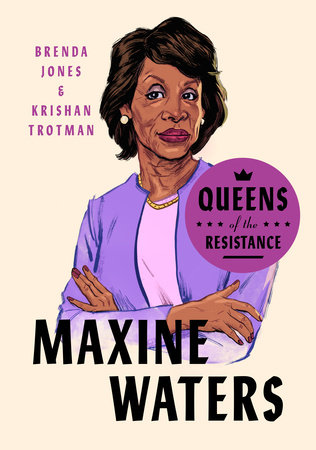RECLAIMING MY TIME
"I got nothing to lose
It's just me against the world."
-Tupac, "Me Against the World"
As a Black woman, a feminist, and a fearless politician who never minces words when it comes to injustice, Auntie Maxine, dubbed by Millennials the Clap-Back Queen and Queen of Shade, is a ferocious, fiery leader who is unafraid to simultaneously rep "the hood" or wield the gavel like an anvil, and does not mind making men who run roughshod over the United States democracy squirm. She's seen it all, and has been through it all.
Maxine Waters, the longest serving Black woman in the US House of Representatives has been in public service for more than forty years. She is the first woman and first African American chair of the House Financial Services Committee. Waters was first nicknamed Auntie Maxine at large back in 2017, after she told the nation that FBI Director James Comey had "no credibility." Her takedown of Comey went viral and she has been the voice many Americans post fist-pump emojis or nod along from their sofas to "Preach!" Auntie Maxine always delivers truth, sis. This queen is not a friend of bowing or biting her tongue in the name of hierarchy. She will come for a president, an attorney general, whoever, anytime she smells injustice.
A very unwise man, Treasury Secretary Steve Mnuchin had to be schooled on how to conduct himself with a queen during a hearing in July 2017 when Auntie Maxine asked about his boss's shady ties to Russian banks. He tried to evade her question about why neither she nor her Democratic committee members had received a response about a letter they sent him months earlier, on May 23. Honey, excuse him because he was new and arrogant. He had just started his job in July-obviously he had not done his homework. He tried to offer Auntie some compliments and sweet talk to wobble around the question: "Ranking member Waters, first let me thank you for your service to California. Being a resident of California, I appreciate everything that you've done for the community there-"'
"Thank you for your compliments about how great I am, but I don't want to waste my time on me," she said. It was simple: get to the point.
"I also want to thank you for the opportunity to meet with me today-"
"Reclaiming my time," she said, shutting down the nonsense.
He continued.
"Reclaiming my time," she repeated again, with a glare, stern and brittle.
He continued-
"Reclaiming my time."
Her eyes set like a hawk, almost piercing though him. "Reclaiming my time."
"Reclaiming my time."
She fired out the words, invoking a House procedure used in committee or on the House floor for retrieving allotted time when a witness or another politician is being elusive. Her words went viral as a reflection of a sentiment that a majority of the nation's voters felt about what appeared to be a morbid opening dance with President Donald Trump, and one that would only continue to get worse for years into his presidency. The American people were fed up with the BS, and Auntie Maxine said what 2.9 million voters (48.2 percent) all wanted to say to Trump: Puhleeasse Do. Not. Waste. Our. Time.
In the hearing, the chairman, at that time Jeb Hensarling, allotted Maxine Waters her time back. She thanked Mnuchin again for his "compliments" and proceeded with the same question. Why the heck hadn't he responded to the letter?
"I was going to answer that-" he offered. Was Maxine Waters going to participate in this child's play? No.
"Please just go straight to answering the question."
"Mr. Chairman," he said to Hensarling, as if giving her the hand and bypassing her, sis. "I thought when you read the rules that you acknowledged that I shouldn't be interrupted and that I would have-"
"Reclaiming my time," Auntie Maxine spat, then looking squarely in the face of the gulping man before her, she said, "What he failed to tell you was [that] when you're on my time, I can reclaim it."
And that, dear sister, is Auntie Maxine.
A GIRL FROM ST. LOUIS
"Long live the rose that grew from concrete
when no one else even cared."
-Tupac, "The Rose That Grew from Concrete"
Auntie Maxine, given name Maxine Moore Carr, was born and came rumbling into the resistance on August 15, 1938, the fifth of her mother's thirteen children, in St. Louis, Missouri. Sis, of course it would be years before she grew into a queen, but this supernova rapped a story glittering with trails of courage from the moment she was born. She grew up facing a salty, racist world, but her family and community knew her worth, and they nurtured her.
Auntie Maxine's mother, Velma Lee Carr, was born in 1916 in Cotton Plant, Arkansas. Velma came of age when the soil was rich and cotton was king. A railroad line eventually changed the business of Cotton Plant from picking to processing, which gave a glimmer of hope to white businessmen, but of course life was still clouded for the workers, those who'd inherited brown skin.
The United States had already been ravaged by the poverty of the Great Depression for nearly ten years, and Jim Crow had ruled the South for almost seventy years.
Black people were looking for a champion, someone who would be bold enough to challenge the forces that confronted them, and the war being waged against them, in every quarter of American society. It seems perfectly fitting that the same year Auntie Maxine was born, a heavyweight champion and son of a sharecropper, Joe Louis, knocked out a German fighter, Max Schmeling, in the first round. Black Americans saw a champion in Joe Louis, but they had no idea that another champ had been born in St. Louis, one who would take their fight to Washington and win some of the most improbable victories.
Before Velma and her husband, Remus Carr, had Maxine, they'd lived in Pine Bluff, Arkansas, where a Black community had existed ever since the Civil War. Union Army forces had set up camp in Pine Bluff, which was at the time still Confederate territory, and it became a magnet for enslaved people who ran away, as well as freed African Americans seeking some level of safety. The army had to set up what were called "contraband camps" to create an organized space for all of them.
After the war ended, Pine Bluff became a place where a society of educated, skilled African Americans thrived. Missionary societies founded schools to educate freed people, and both adults and children began to gain an education. The Branch Normal School of Arkansas Industrial University was developed. A historically Black college, it ultimately became the University of Arkansas at Pine Bluff, the oldest and largest Historically Black Colleges and Universities (HBCU) in the state. Pine Bluff began to develop a bustling Black community with a thriving main street filled with Black-owned businesses-barbershops, banks, and bars. Wakanda is fictional, but places like Pine Bluff, Arkansas, or Tulsa, Oklahoma, were not, and they became staples for Black prosperity right in this country.
The spirit of Pine Bluff would live in the soul of Velma, and she'd spill it over into the hearts of her children. That spirit created the root of social justice that continues to fuel Maxine Waters today, the origin of her strength and hope for Blacks in America that stems from lands that her mother knew, like Pine Bluff.
When Velma was about ten years old, the Great Flood occurred. This seminal event would affect the lives of everyone in Pine Bluff. This Mississippi River flood was actually the first time in recent history when the levees broke, long before Hurricane Katrina. It devastated and swallowed the nearby crops and farmland, and the region struggled to recover, not knowing that just three years later, the 1929 stock market would crash hundreds of miles away in New York City, and the Great Depression would hang over the nation for more than a decade.
The region was battered, but it soldiered on, and through it all, St. Louis remained a bustling industrial city. Roosevelt's Works Progress Administration built a highway system that made travel between cities more accessible. St. Louis is right on the eastern edge of Missouri, one state away from Kansas, which had rejected slavery and represented a new frontier of freedom during the Civil War. With one hand in the South and the other in the North, Missouri played a middle position between the Union and Confederacy; it held two governments with representatives on both sides of the conflict, some serving in the US Congress and some serving in the Confederate Congress. By 1861, the Union gained control and Missouri was considered a Union state.
St. Louis was a sophisticated Black community, baby, which was assisted by a series of nine very industrious Free Masonic Lodges that invested in the community. They helped newly arriving Black migrants from farther south find jobs and housing, and offered relief for food and clothing. They also contributed to Black charities and supported the education of young people. By the 1930s, St. Louis Blacks had moved beyond the struggle to survive. They were soaring. Soon most prominent members of the community were part of one Masonic Lodge or another and African Americans flocked to the city to find culture, opportunity, and the support of a welcoming arena.
Education had been a staple of the Black community there since before the Civil War. John Berry Meachum, a pastor of the First Baptist Church in St. Louis in 1827, created Lincoln Institute, the first school for African Americans in the city. Five more schools connected to African Methodist Episcopal and Black Baptist churches were created in St. Louis, and both denominations were active participants in the abolition of slavery from the 1840s. But unfortunately, sis, fear that educated Blacks would influence those who were still enslaved led to the passage of a law in Missouri making it illegal to educate African Americans inside the borders of the state.
Pastor John Meachum remained undaunted and set up a school on a barge on the Mississippi River bordering St. Louis-outside the jurisdiction of the state. It was an act of resistance, a squeeze to the muscle needed to upend the circumstances caused and residue created by slavery. After the war, Missouri made it mandatory that all boards of education support African American education, and twelve schools for African Americans, including Summer High School were born. St. Louis was a city invested in Black opportunity.
Soon enough, Remus and Velma, Maxine Waters's parents, made their way to St. Louis with the children. Life would continue to unfold quickly for Velma, Maxine's father left the family when Maxine was two. But Velma was familiar with survival. As a child she had lost her mother when she was only five years old, and was raised by her grandparents, Doke and Florence Eldridge. Now Velma went on with determination and courage to raise her children the best way she could. Soon she married again, to Samuel Willie Moore.
Prior to the move to St. Louis, the family spent a short time in Kinloch, Missouri, the first African American community to be incorporated in the state. In an interview with Lenny Letter, Auntie Maxine remembers Kinloch with great pride: "It was a very warm community where everybody knew everybody. We were accustomed to Black entrepreneurs where we shopped at our grocery store and at our bakery. Our schoolteachers were black. We had a very positive image of black leadership throughout our community."
When she says "our," what Auntie Maxine means is Black-owned, otay.
Today, Auntie Maxine is known as a shrewd protector, fly as hell in a suit and unassuming with that bright smile. But don't be fooled. Like a honey badger, she will take out any rival that steps in her den, and digest his bones and feathers if he starts acting up. It was in the community of Kinloch that she started developing those skills, where she was first inspired to be the tough leader who could still love, and be tender, and champion her people to persevere yet equally rebel against the wrongdoings. Kinloch was enveloped by Blackness due to segregation, and racism was a tool to withhold the Black community from rising up, but like baby whales the children of the community swam on the backs of the Black elders and moved along in life, anyway. Auntie Maxine loves Black men and can quote their wisdom, from Frederick Douglass to Tupac Shakur, but it was specifically the Black women she credits for making the difference in her life. This positive image of what it meant to be African American and a woman, forged in Waters, in her formative years, the idea of being a fierce activist and capable leader for African American people and communities around the world.
Velma eventually settled her children permanently in St. Louis, and by the time Maxine was two years old, Velma was a single mother of thirteen living in one of the first housing projects in the country. They were on and off welfare, as Maxine puts it, depending on if Velma could uphold a job with all the demands of motherhood and childcare on her back. The housing projects themselves had a complicated history. Though poverty existed in St. Louis, so did self-respect, and examples of success abounded among people who found themselves part of the working class. Determined, however, to break up the basis of their power, white separatists began to develop plans to raze entire Black neighborhoods under the guise of urban renewal. So-called urban renewal would destroy the intricate networks of community that had been a decades-old framework of support that ensured the poor were never destitute, hungry, or without.
The largest so-called developments were built shortly after World War II, just as St. Louis had become a mecca for Black culture due to a community of extremely successful African American individuals living there. Miles Davis, who was born around the same time as Maxine, must have spent a lot of time in St. Louis, which was just across the river from his birthplace. A young Charlie Parker Parker, creator of bebop, visited from Kansas City. It was a cultural center, and as a little girl, Maxine Waters was in the midst of it.
But there were also many challenges. During the 1940s and '50s, the city of St. Louis had more than 85,000 families living in housing tenements, many with only communal toilets. The projects were racially segregated, and as middle-class whites were leaving the city, low-income Black families were moving in (and it remained segregated until 1956 when Auntie Maxine graduated high school, but more on that later).
Copyright © 2020 by Brenda Jones. All rights reserved. No part of this excerpt may be reproduced or reprinted without permission in writing from the publisher.








